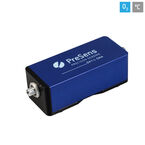Tutorials, Webinare und informative Videos über unsere optischen Sensorsysteme
Präzise Sauerstoffmessungen unter realen Bedingungen
O2 Sensorspot SP-PSt3-NAU
Sensorspots sind die vielseitigste Ausführung nicht-invasiver optischer Sauerstoffsensoren. Die rote Seite des Spots kann an der Innenfläche eines transparenten Glas- oder Kunststoffgefäßes befestigt werden, wie z. B. in Schüttel- oder Rührkolben, Kulturröhrchen, Petrischalen oder Kultivierungsbeuteln. Der Sauerstoff wird berührungslos und zerstörungsfrei durch die transparente Gefäßwand gemessen. Der SP-PSt3-NAU hat einen Messbereich von 0 - 100 % Sauerstoff in gelöster oder gasförmiger Phase. Die sauerstoffempfindliche Beschichtung ist auf einer flexiblen, transparenten 125 μm Polyesterfolie fixiert, die nicht autoklaviert werden kann.
- Nicht-invasive Messungen durch eine Gefäßwand
- Kein Sauerstoffverbrauch
- Das Signal ist unabhängig von der Strömungsgeschwindigkeit
- O2 Messungen in Flüssigkeiten & Gasphase
Anwendungsbereiche
Bioprozessentwicklung: Sauerstoffüberwachung in Schüttelkolben
Die Versorgung mit Sauerstoff ist eines der Hauptprobleme bei der Kultivierung aerober Organismen. Schüttelkolbenkulturen werden häufig in der akademischen und industriellen Bioprozessentwicklung angewendet. Da adäquate Methoden zur realen Überwachung von gelöstem Sauerstoff fehlten, wurde bisher üblicherweise von einer ausreichenden O2-Versorgung ausgegangen. Nun überwachen die nicht-invasiven Sauerstoffsensoren, dass genügend Sauerstoff in den Schüttelkolben vorhanden ist und geben neue Einblicke in die Stoffwechselaktivität.
Atmung & Photosynthese: Sauerstoffüberwachung in Glasfläschchen
Die Bestimmung der Atmungsaktivität erfolgt häufig für Wasserorganismen wie Wirbellose, Larvenstadien oder Eier, aber auch für Bakterien, Zellkulturen, Hefen oder Pilze. Für Algen ist die Messung der photosynthetischen Aktivität von großem Interesse. Mit unserem 20 mL SensorVial mit integriertem Sensorstreifen kann Sauerstoff gleichzeitig in der flüssigen Probe und im Kopfraum gemessen werden. Autoklavierbare SensorVials für gerührte und nicht gerührte Anwendungen sind erhältlich.
Technische Daten
| Spezifikationen | Gasförmiger & Gelöster O2 | Gelöster O2 |
|---|---|---|
| *nach Zwei-Punkt-Kalibrierung wie im Handbuch beschrieben | ||
| Messbereich | 0 – 100 % O2 0 – 1000 hPa | 0 – 45 mg/l 0 – 1400 µmol/l |
| Nachweisgrenze | 0,03 % Sauerstoff | 15 ppb |
| Auflösung | ± 0,01 % O2 bei 0,21 % O2 | ± 0,004 mg/l bei 0,091 mg/l |
| Genauigkeit* | ± 0,4 % O2 bei 20,9 % O2 ± 0,05 % O2 bei 0,2 % O2 | |
| Drift | < 0,03 % O2 innerhalb von 30 Tagen (Messintervall von 1 Min. / bei 0% Sauerstoff) | |
| Messtemperaturbereich | von 0 bis + 50 °C | |
| Ansprechzeit (t90) | < 6 Sek. | < 40 Sek. |
| Eigenschaften | ||
| Kompatibilität | Wässrige Lösungen, Ethanol, Methanol | |
| Keine Querempfindlichkeit | pH 1 – 14 | |
| Querempfindlichkeit | Organische Lösungsmittel wie Aceton, Toluol, Chloroform oder Methylenchlorid Chlorgas | |
| Sterilisationsverfahren | Ethylenoxid (EtO) Gammabestrahlung | |
| Reinigungsverfahren | Cleaning in place (CIP, 2 % NaOH, + 80 °C, + 176 °F) 3 % H2O2 Säurehaltige Mittel (HCl, H2SO4), max. 4 – 5 % Ethanol Wässrige Lösungen | |
| Kalibrierung | Zwei-Punkt-Kalibrierung in sauerstofffreier Umgebung (Stickstoff, Natriumsulfit) und luftgesättigter Umgebung | |
| Lagerbeständigkeit | 60 Monate, sofern das Sensormaterial im Dunkeln gelagert wird | |
Passende Produkte
Weitere Informationen
Publikationen
FAQs
Bedienungsanleitungen
Broschüren
Software
PreSens Datamanager version 2.0.0.57 - Windows XP/Vista/7/8
PreSens Oxygen Calculator version 3.1.1 - Windows 7/8/10



















